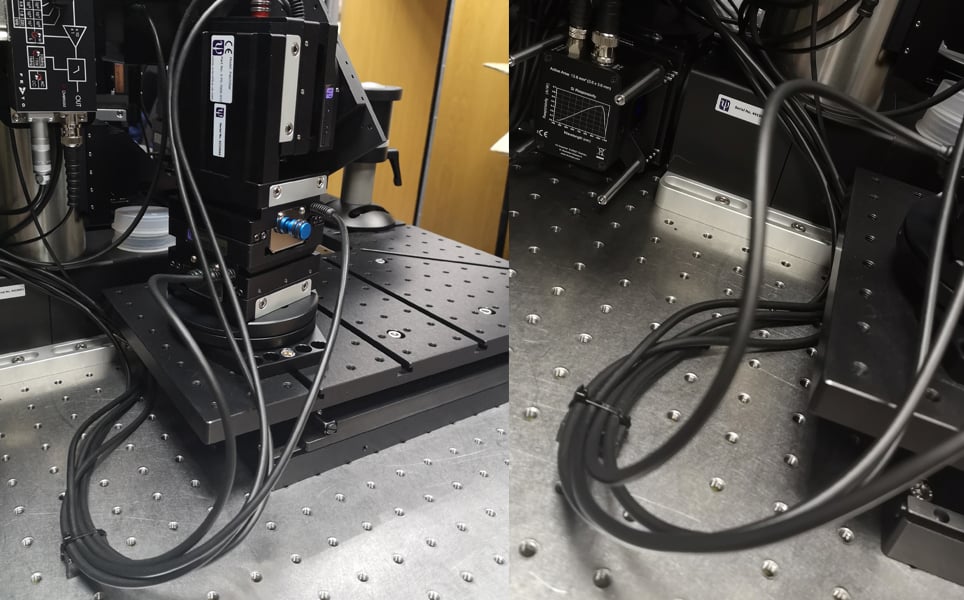
Tips for reducing pipette drift in electrophysiology experiments
Pipette movement, also known as drift, during patch clamp electrophysiology recordings is a nightmare for electrophysiologists. It disrupts recordings and distorts results, and can also affect reproducibility, leading to delays in publishing. Here are some troubleshooting tips to help identify and resolve causes of drift to keep your experiments running smoothly.
1. To fully understand the extent of the drift, it is a good idea to record images of the pipette during a one-hour period. Acquiring images every two-five seconds provides the best analysis for any patching that will be of a long duration, but if this isn’t possible, then at least every 10 seconds. After acquiring the images, analyse the drift. Be mindful that the drift could be in any of the three axes. Sometimes an x or y drift could be the result of a vertical or z drift. With these images, you will be able to better identify the reason or the frequency of the drift, as well as how far the pipette drifts.
2. Check if the air table has the correct pressure across it and that there is nothing preventing the table from dampening the vibrations from the floor. It is useful to have a live image of the pipette whilst you walk around and near the table, so you can check if the vibration from the floor is being transferred to the table and the pipette.
3. Check the manipulator isn’t mounted onto the stage or table too loosely or too tightly; the screws only need to be as tight as can be achieved by hand. Similarly, the screws holding the individual axis of the manipulator also need to be secure, but not too loose or tight.
4. Check for airflow around the micromanipulator. If there is any, for example coming from a fan or air-conditioning, try to redirect it or stop it completely.
5. Be mindful of the ambient temperature of the room where the setup is located. If there is a huge temperature fluctuation, dimensions of the materials making up the pipette holder or the micromanipulator will change, resulting in drift.
As a note, pipette holders made from a polymer can have greater thermal expansion than quartz.
6. Ensure that the pipette you are using is being held properly by the pipette holder and that the o-rings (or cone washers) are in good condition. If the washers are old, they will not hold the pipette very well. If the pipette cap is not fastened all the way, the o-ring will be loose, which will allow the pipette to move. And if the pipette is not all the way to the barrel, properly sitting in the recess, it will also vibrate more. If you have an electrode holding bar, this can be used instead of the pipette holder to check this.
7. Check when the manipulators were last serviced. If using Scientifica micromanipulators, it would be useful to do the following at least once a year:
a. Move the micromanipulator over the full range back and forth on the x-axis, at least 20 times.
b. Repeat for all the other axis, at least 20 times each.
c. Change the position of the micromanipulator slightly (doesn't need to be more than a millimetre or so). If this causes any changes, such as different sounds, please contact your local representative for assistance.
8. The cables and tubes that are hanging from the manipulator should be securely held on to the table. They should be secured at least at one point close to the manipulator and another point at the end of the table. Leave a bit of give between the manipulator and the first point, so the manipulator can freely move in any direction without pulling the cables or being stopped by them. This should be checked regularly just in case anything has changed, for example something has moved or is pressing on the cables.
When securing the cables to the table, it is important to ensure this is done when the stage and micromanipulator are positioned at the furthest point away from where the cables are tied, to ensure there is enough give.

Here are a couple of points to remember in terms of the cables and tubes:
- Don’t forget that the air tube for the pipette holder can exert some force onto the system, causing movements or vibration. This tube also needs to be secured to the table at a minimum of two points.
- If you are still experiencing problems because of the cables and tubes, one solution is to use a stand and clamp to hold them. If you leave the cables at the same height as the centre of rotation, there will be less pulling forces and weight affecting the manipulators.
9. Check the slice you are using for the experiment. Sometimes the slices can move because they are not being weighed down by the slice holder (or harp). This will cause the slice to move and the patching to become loose.
10. Lastly, check the chamber:
- Ensure the level of the solution in the chamber is constant, as fluctuations will cause changes in the chamber microenvironment that can influence both the slice position and the pipette position.
- Check that the perfusion system is not causing any vibration with a constant frequency on the solution. Test this by stopping the perfusion while looking at the pipette recording.
- Keep the perfusion tubing and the chamber clean by regularly washing through with distilled water. Replace tubing and chamber cover slips if necessary.
For further advice and guidance, please contact our team of specialists at [email protected].
Sign up to receive our latest news
Find out about Scientifica's latest product releases, company news, and developments through a range of news articles, customer interviews and product demonstration videos.

)